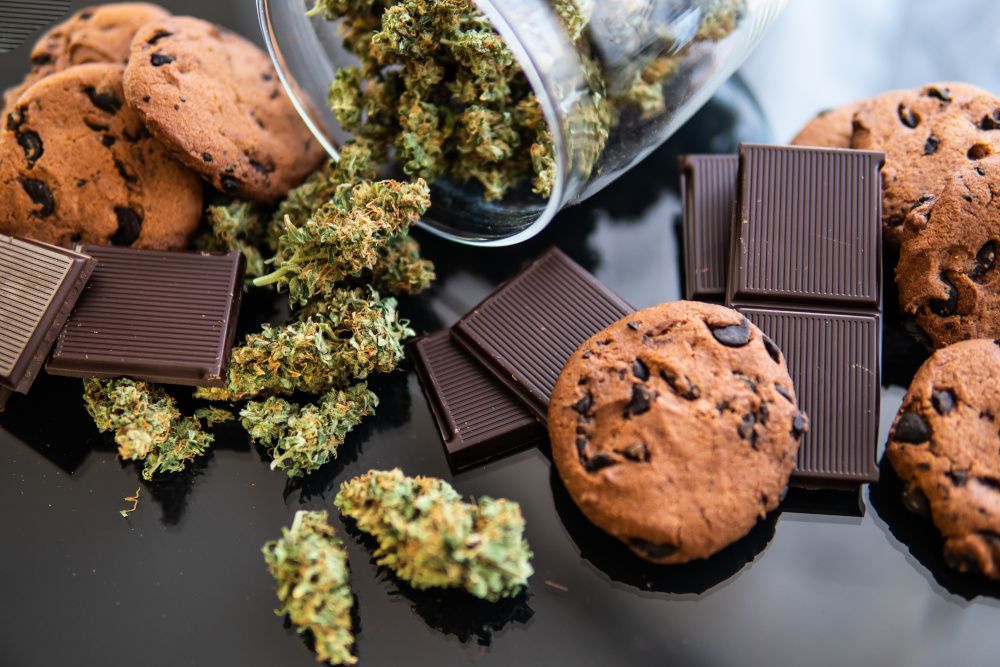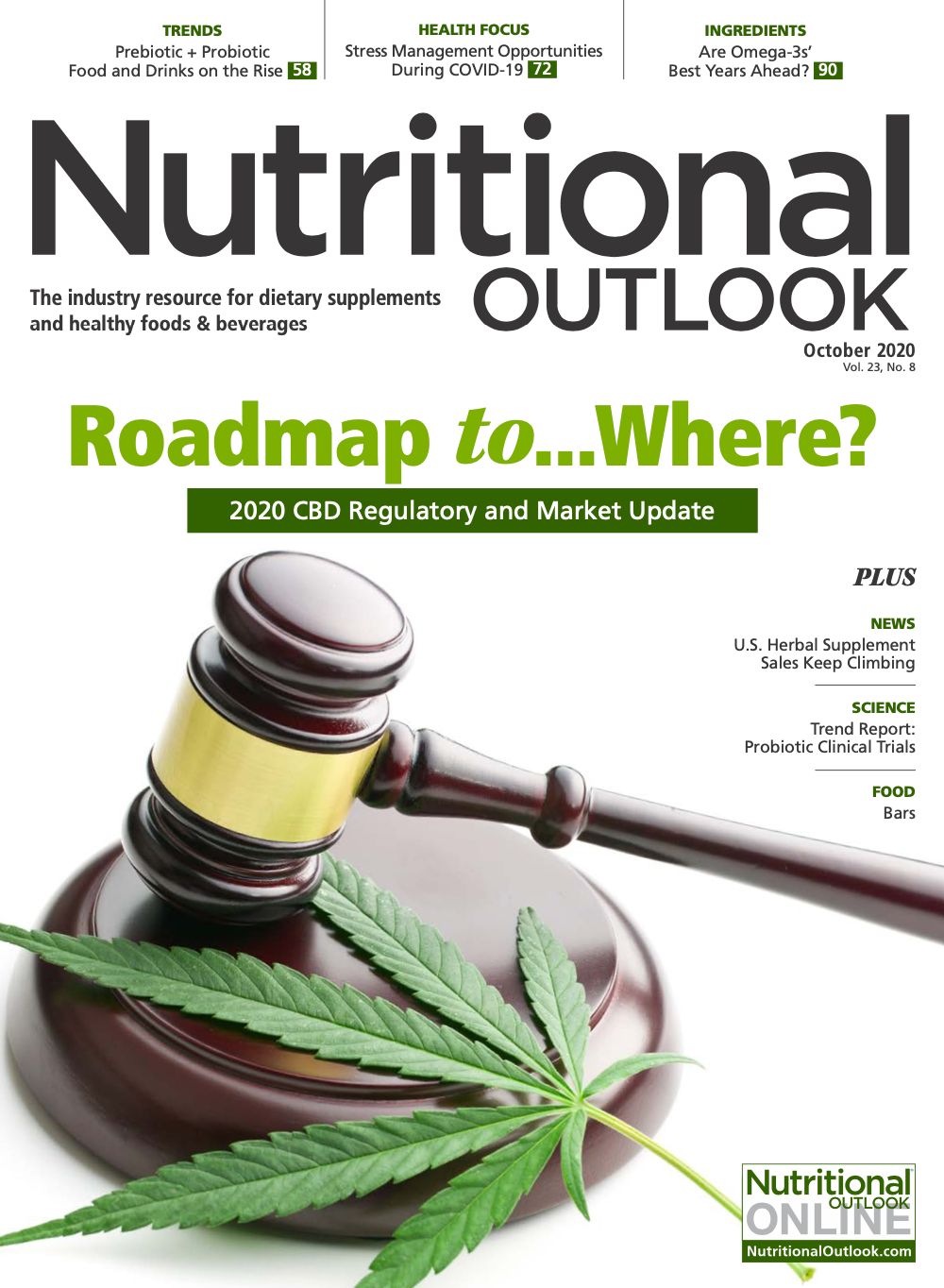Formulating CBD food, drinks, and edibles? A food scientist explains the challenges.
How do you formulate a high-quality CBD edible product, including food and drinks? Food scientist Kantha Shelke gave a crash course during Nutritional Outlook’s webcast.
Photo © AdobeStock.com/cendeced

Demand for CBD edible products—from food and drinks to candy, gummies, chocolate, and even pet treats—is growing fast. But the challenges of formulating cannabidiol (CBD) into these non-pill matrices are vast especially due to the rigors of food processing. Food scientist, author, and educator Kantha Shelke, PhD, CFS, principal, Corvus Blue LLC (Chicago), shared key insights and tips on formulating CBD edibles during an August 13 Nutritional Outlook webcast titled “CBD in Food: A Challenging Road Ahead.”
Starting Material Matters
Starting with a high-quality CBD active ingredient produced to exacting specifications is especially critical if that ingredient is to be used in food production. The rigors of food processing will by nature challenge the stability, behavior, and potency of a CBD extract, so starting with the highest-quality ingredient from the get-go is a formulator’s best bet.
For instance, when CBD is extracted from the cannabis plant (Cannabis sativa), it undergoes numerous pre-processing and post-processing steps, including pre-processing decarboxylation, which involves heat. (Phytocannabinoids like CBD remain inactive and don’t work on the body’s endogenous endocannabinoid receptors until the carboxyl group is removed through decarboxylation.) The quality of the decarboxylation process performed during pre-processing will determine the quality and potency of the active cannabinoid even before it is formulated into the edible product.
When one smokes or vapes CBD, the heat involved activates decarboxylation. The same isn’t true when one is producing a CBD edible. Shelke provided an example. “If you’re going to put [the CBD] in chocolate, chocolate would not tolerate the temperatures that are required for decarboxylation because the chocolate would melt and the whole product would be destroyed. So all of this has to be done upfront, and with precision,” she said. Pre-processing and post-processing conditions will also impact the ingredient’s aroma, flavor, and astringency—all characteristics that can impact the profile of an edible.
Edible-product manufacturers should thus ensure that their ingredient suppliers are providing high-quality material and should carefully study a product’s Certificate of Analysis “and learn what works best for your product,” Shelke advised. “If you’re in the edible-formulation business, it’s really important that you learn how your cannabis derivative was made and that you know what it is (such as its melting point), how much of the active ingredient is in it, what else is in it, and what is not in it. Because answers to these questions have a profound effect on the quality and safety of the finished product.”
Understanding Cannabis Bioactives
Formulators must also understand the unique properties of the cannabis bioactives and how these characteristics can affect an edible formulation.
For instance, Shelke said, cannabinoids are hydrophobic, meaning they are not water-soluble. Cannabinoids also have a high melting point and are “almost waxy,” she said. Cannabis terpenoids are volatile, non-polar, and “have a very distinctive odor and taste. They have good antioxidant, antimicrobial, and anti-inflammatory properties, and they modulate cannabinoid activity.” At the same time, terpenoids can result in off-flavors. The alkaloids in cannabis are important but can also be astringent, which can impact an edible as well.
“One really has to know what you’re putting into your food and know that the bioavailability and bioactivity depend on the matrix of that food, whether it’s an edible or beverage, because they will then determine the effect based on how they’re used or consumed. So, there’s a lot more than just mixing it in and devouring or slurping it down,” Shelke said. For instance, cannabis terpenes can become oxidized if heated improperly and can create carcinogens. Flavonoids can change the color of an edible. And alkaloids can impact the product’s taste.
Food Processing
The rigors of food processing can change the nature of an active ingredient. “Preparation of edibles really matters because most foods are manufactured under harsh conditions,” Shelke explained. “You’ve got temperature, you’ve got moisture, pH, and all of these influence the cannabinoid chemistry.” Shelke provided some examples of issues to keep in mind when formulating different food types.
Baked goods: Baked goods usually contain a fat source like butter, margarine, or shortening. Something formulators should note is that because cannabinoids are hydrophobic and dissolve in fat, during baking they will mix with the fat-based ingredients and dissolve and spread throughout the mixture. It’s also important to know that the lower temperatures involved in baking mean there shouldn’t be much loss of the cannabinoid due to volatilization because cannabinoids have a relatively high boiling point.
Confectionery: There are key differences between formulating a gummy versus a chocolate versus a hard candy or lozenge. For instance, chocolate is fat-based. “This fat naturally increases the cannabinoids’ bioavailability,” Shelke noted. Gummies, on the other hand, do not contain a fat source, “so it makes it very difficult to incorporate hydrophobic cannabinoids within that,” she said.
Extruded products: Extruded foods like pet treats or nutrition bars are sent through an extruder, which can affect the phenolic content and viability of antioxidants, which can also impact flavor, aroma, and palatability. Prolonged exposure to heat is also a concern.
Beverages: CBD is not water-soluble, and formulating it into water-based beverages is always a challenge, said Shelke. “You’re talking about mixing oil and water, and you’re trying to keep them suspended so that they don’t cream up at the top or settle down at the bottom. That really has been the greatest problem that most CBD beverages in the market face,” she said.
Stability and Efficacy
Major considerations when working with CBD food matrices include ensuring the stability and efficacy of CBD. In terms of stability, formulators must consider how the other ingredients in a product, as well as the matrix itself, will impact shelf life and efficacy once the product is consumed.
Formulators must also determine the pharmacokinetics of CBD once ingested in the food product. For instance, how long will it take for the active ingredient to have an effect? “With edibles, what matters most is the psychoactive effects. That’s what consumers are buying it for,” said Shelke. “In edibles, this peaks around 30-90 minutes after you’ve eaten it, after ingestion. But it’s only 10-15 minutes if you’re inhaling the product. And this peak effect may be delayed over a range of hours—as much as 2-6 hours—and can even go as long as 8 hours. And in some people, this effect can last much longer because the food matrix decides the bioavailability and the bioactivity. So it’s really important to know the physical, chemical, and physiological effects that are occurring when this material moves from the ingested food to the site of action inside the human body.”
For beverages, voiding is also a concern. “Beverages mean rapid absorption, but beverages also mean rapid voiding, so what you’re ingesting also leaves your body rather rapidly,” Shelke warned.
Setting Expectations
Manufacturers should also ensure consumers understand the unique properties and effects of edibles as opposed to dietary supplements.
Said Shelke: “The potency of only-ingested cannabinoids depends on many factors. These factors have to be carefully considered when you’re designing effective, food-based delivery vehicles. Most of all, you have to keep in mind that your customer should not compare them to a dietary supplement where you’re just popping a pill or a capsule, or to something they are vaping, because the food system is completely different.”
Shelke shared many more CBD formulating tips and insights during this free webcast. To watch this free webcast on demand, click here.

Kaneka Nutrients to unveil new consumer research on menopausal women at Vitafoods Europe 2024
April 26th 2024The company will reveal the results of the research that is based on live feedback from 200 menopausal women who took 200 mg per day of Kaneka Ubiquinol over two-months, monitored the effects, and recorded their observations.
Rousselot to showcase new collagen peptide research and targeted solutions at Vitafoods Europe 2024
April 25th 2024The company will be highlighting new research that demonstrates the ability of its Peptan collagen peptide brand to support sleep quality, reduce gastrointestinal discomfort, and enhance skin health, including density, hydration, and elasticity.